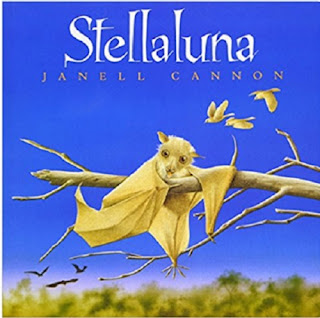 |
What Skeet Sees
 |
| My photo of book cover |
Skeet is a young deer mouse who lives
in a burrow on a spruce knoll above a swamp in a peaceful
valley. A brook runs past the knoll toward a pond. Skeet lives with
his mother, his sister Samantha, his baby brother Loopey, and his
grandfather, Overdare.
One day while he's getting a drink in
the brook, he hears something making a loud splashing sound. He was
curious, so he drew nearer to the sound. He heard a high-pitched
whistle. The splashing stopped. Then he saw a dark brown head looking
cautiously around an edge of grass. He had never seen such an odd
creature as that which emerged. He thought it looked comical with its
large orange front teeth and its paddle-like tail. Skeet stopped
being afraid because he could see this awkward creature would never
be fast enough to catch him. The creature was soon joined by five
more like it.
Skeet ran home to ask Overdare what
these creatures might be. “'Beaver!' exclaimed Skeet's
grandfather....'I hoped I'd never see in my lifetime when beaver get
into this valley.'” (p, 7)
Overdare confirmed the beaver weren't
dangerous to mice, since they didn't eat meat. So Skeet couldn't
understand why his grandfather didn't want them around. Overdare
explained:
“Beaver...think they know the way
everything ought to be in any place they settle down. If it isn't
that way, they make it so, and they don't care a bit what happens to
anyone else in the process.” (p. 8)
What the Beavers Do
Grandfather hopes the beaver will
leave, but curious Skeet hopes they hang around long enough for him
to watch. And watch he does. He sees the beavers build a dam, chop
down trees, raise the level of the pond, build a canal for
transporting logs from the places where they had felled them, and
build a second dam. The water level kept rising higher and higher.
 |
| Photo of p. 16-17, Beaver Valley, Leslie Morrill's illustration, text by Walter D. Edmonds |
What Author Walter D. Edmonds Thinks of
Beavers
Edmonds was raised in upper New York
State in the small town of Boonville. He frequently observed beaver
at his family home, Northlands, along the Black River . He personally
saw how negatively the beavers impacted the ecosystem when they moved
into an area.
Beavers have always fascinated me. Most
of us who have never seen one in the wild think of them positively because they are such industrious animals. Teachers often hold up the hardworking beavers
as examples their students should follow. Edmonds seems to see them as
industriously destroying their environment to please themselves.
He reveals this attitude in one of the
book's last sentences. He describes a mother who had brought her
young son to the spruce knoll for a picnic to see the beaver ponds.
She wanted to teach her son some natural history. She didn't seem
interested in all the dying trees whose roots had gotten too wet. She
was only interested in all the work the beavers had done building
their dams, their home, and their canal. Let's eavesdrop on her:
“Isn't it wonderful,
Tommy?....They're as clever as engineers. They're just like men.” (p, 69)
Should You or Your Child Read This Book?
Whether you love beavers or not, you
will learn a lot about their behavior in this book from one who has
observed beavers over time. Older readers will pick up the author's
attitude. The book would be perfect to read aloud as a family and
discuss.
The author shows us each step in the beavers'
transformation of the valley, and suspense builds as the water level
rises. Skeet at first is just curious. But as the water level
continues to rise, he realizes that animals in burrows on lower
ground will lose their homes. Some don't get out in time and are
trapped to die. Skeet and his family wonder if they, too, will have
to find a new home.
The copy of the book I have is
illustrated by Leslie Morrill. I love her drawing of the beavers and
the mice. Her hand-drawn maps help readers keep track of the changes
in the valley.
 |
| Photo of p. 10-11, Beaver Valley, Leslie Morrill's illustration |
This is chapter book is at a grade
3-5 reading level. It's a great book for homeschoolers. Almost any age from kindergarten on will find it
interesting. Why not get a copy for your home library?
This book is out of print. It is still available at Amazon.
All quotes and book illustration photos are from this book: Beaver Valley by Walter D. Edmonds, illustrated by Leslie Morrill; Little, Brown and Company, 1971.
Learn more about beavers and other wild animals in my review of Nature's Everyday Mysteries. I review some of my favorite picture books about animals here. You may also enjoy fellow contributor Renaissance Woman's review of Deep Creek.
Note: The author may receive a commission from purchases made using links found in this article. “As an Amazon Associate, Ebay (EPN), Esty (Awin), and/or Zazzle Affiliate, I (we) earn from qualifying purchases.”




































